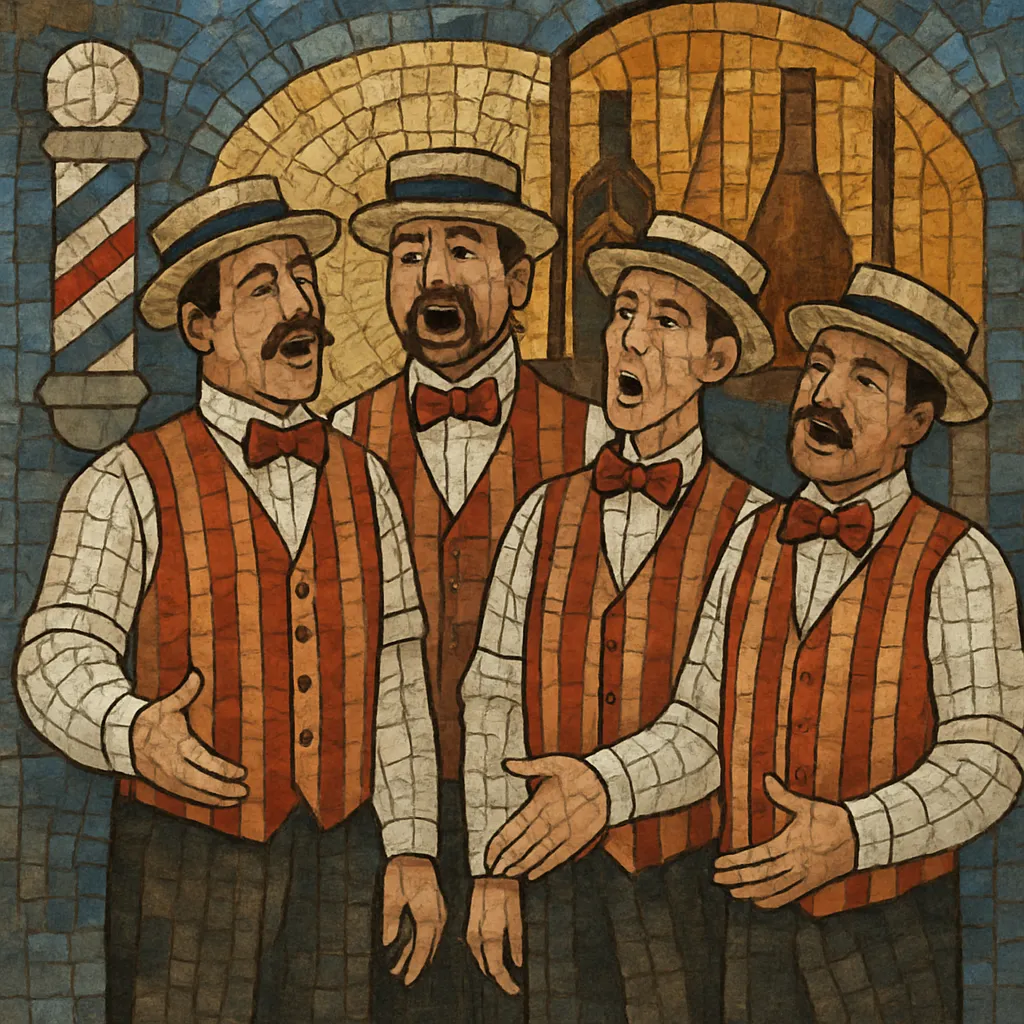
Barbershop is a four-part, a cappella vocal harmony style built around a lead melody with tenor, baritone, and bass parts that lock chords to create "ringing" overtones.
Its hallmark sound emphasizes dominant-seventh-rich harmony, homophonic textures, and expressive devices such as swipes, echoes, and tag endings.
The repertoire traditionally draws on late-19th- and early-20th-century American popular songs, with lyrical themes that are romantic, sentimental, or humorous.
Performance values center on unified vowels, precise tuning (often approaching just intonation), balanced resonance, and coordinated interpretation.
Barbershop harmony emerged in the United States in the late 1800s within African American communities, where informal quartet singing blended spirituals, gospel hymnody, minstrelsy repertoire, parlour music, and popular songs of the Tin Pan Alley era. The style favored close, consonant voicings and the pleasure of spontaneous harmonizing—often in barbershops, social clubs, and street corners.
By the early 1900s, published songs and vaudeville acts helped spread quartet singing. After interest waned during the Jazz Age, a preservation movement took shape with the 1938 founding of SPEBSQSA (now the Barbershop Harmony Society), which standardized competition rules, voicing conventions, and stylistic norms, codifying the now-classic “barbershop chord” emphasis.
National and regional contests multiplied, fostering a canon of arrangements and a performance practice rooted in unity of sound, expressive interpretation, and theatrical presentation. Women’s organizations—Sweet Adelines International (1945) and Harmony, Incorporated (1959)—expanded the art form and developed parallel standards and competitive scenes.
From the late 20th century onward, barbershop spread internationally, with choruses and quartets flourishing in Europe, Oceania, and Asia. Contemporary ensembles retain core harmonic language while embracing wider repertoire, refined pedagogy (vocal science, tuning strategies), and innovative showmanship. The style’s legacy can be heard in doo-wop, vocal jazz, and modern a cappella traditions.
Write for four parts: Lead (melody, typically mid-range), Tenor (light harmony above the lead), Baritone (fills chordal gaps, flexible line), and Bass (foundation, clear low tones). Aim for matched vowels and a unified ensemble timbre.
Center the progression around dominant-seventh chords and circle-of-fifths motion. Feature the “barbershop chord” (1–3–5–♭7) and frequent secondary dominants. Keep the melody in the Lead while Tenor and Baritone move with contrary or oblique motion to avoid voice crossings and parallel perfect intervals. Favor just-intonation tuning tendencies (lowered major thirds, pure fifths) to encourage overtone “ring.”
Use predominantly homophonic textures with coordinated rhythms. Employ barbershop idioms—swipes (rhythmic chord shifts on a sustained lyric), echoes, bell chords (staggered entrances across parts), and tags (cadential codas spotlighting overtone lock). Maintain clear cadences and memorable turnarounds.
Common meters are 4/4 and 3/4 at moderate tempos. Align consonants and sustain vowels; craft phrase shapes with dynamic swells. Allow rubato or subtle tempo nuance for expressive lyrics, but keep rhythmic unity across parts.
Choose singable, emotionally direct texts—romance, nostalgia, humor—often from early American popular song. Ensure lyric underlay supports unified vowel shapes; avoid overly dense word painting that disrupts vertical alignment.
Balance chords from the bass up; tune key chord tones (3rds/7ths) to ring partials. Standardize vowels (e.g., using a shared vowel chart) and synchronize breaths. Refine showmanship—facial expression, storytelling, and visual unity—to match musical phrasing.

